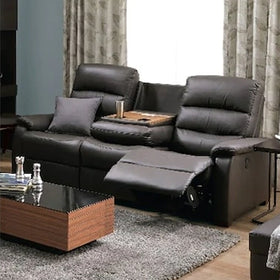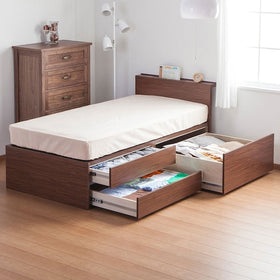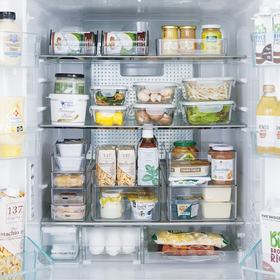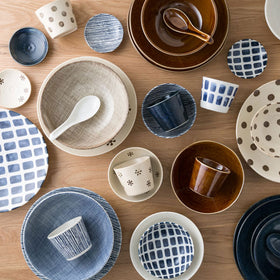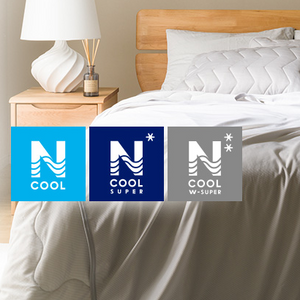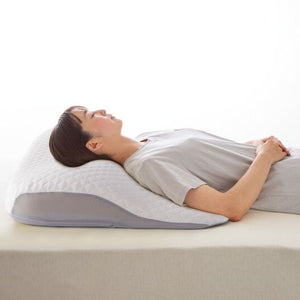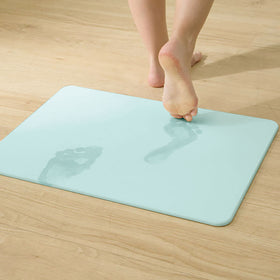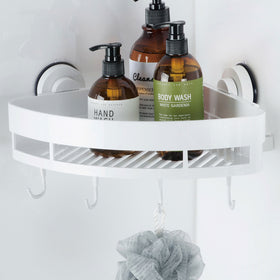Sustainability at NITORI

The UN created these 17 Sustainable Development Goals (also known as Global Goals or SDGs) in 2015 to raise awareness about these important issues.
NITORI's vision and purpose is to help the world run better and improve people's lives, which is why we have embraced the 17 Sustainable Development Goals from the very beginning of our journey. We aim to be an enabler and an exemplar for contributing to the SDGs. With our broad reach, we believe we have both, a responsibility and an opportunity to help achieve the SDGs.
 Product development using eco-friendly materials
Product development using eco-friendly materialsThe Nitori Original Landsell, which was jointly developed with the material manufacturer Teijin, is an environmentally friendly product that uses recycled fibers made from PET bottles as the raw material.
As a result of a survey based on LCA (life cycle assessment = method of environmental load evaluation in product manufacturing, transportation, sales, use, disposal, and reuse), this recycled fiber has CO 2 compared to the case where petroleum is used as a raw material. 47% in emissions Note , there is a 33% of the environmental load reduction in energy consumption.
 Improved packaging without relying on Styrofoam cushioning material
Improved packaging without relying on Styrofoam cushioning materialStyrofoam has excellent shock absorption and elasticity, and is ideal as a packaging material and cushioning material for furniture, but after use, it is incinerated at a high cost.
At NITORI, we decided not to use Styrofoam as the packaging material for finished furniture, and by eliminating the Styrofoam packaging material and cushioning material, we were able to improve the environment.
We have been able to reduce the amount of Styrofoam used by about 34 tons annually, and we have a track record of reducing CO 2 emissions by incineration by about 115 tons. (FY2017 results) In addition, the reduction of garbage generated when furniture is delivered leads to a reduction in delivery time, which also contributes to the CO 2 reduction effect by improving delivery efficiency.
 Streamlining transportation by reducing the packaging size of products
Streamlining transportation by reducing the packaging size of productsBy reducing the packaging size of products, we are working to increase the number of products that can be carried at one time and reduce the number of shipments. This contributes to a significant reduction in CO 2 emissions.
Until now, we have been targeting relatively small products such as cushions and futons, but now we are also working on spring-loaded bed mattresses, which are large furniture. This bed mattress compression is expected to reduce the number of containers by about 800 containers per year and CO 2 emissions by about 550 t-CO 2 per year.
 Utilization of eco-packaging materials
Utilization of eco-packaging materialsFor the transportation of furniture products between bases, we use reusable special packaging materials to reduce the amount of corrugated cardboard and urethane foam used. In fiscal 2014, we introduced special packaging materials for box furniture (cupboards, etc.) to approximately 200 stores nationwide. We will continue to expand and introduce it in the future, and it is expected that we will be able to reduce the amount of garbage emitted by 55 10t trucks annually.
 Simplification of product packaging
Simplification of product packagingWe are making efforts such as eliminating unnecessary individual packaging and promoting FRM (floor ready merchandising = products that eliminate individual packaging and can be displayed as they are when delivered to stores).
 Product development utilizing waste wood and waste plastic
Product development utilizing waste wood and waste plasticThe Nitori Corporate Division has been well received by proposing outdoor benches made from waste wood and waste plastic to corporate customers.
 Introduction of electric vehicle charging equipment
Introduction of electric vehicle charging equipmentWe have introduced electric vehicle charging equipment at the Aso store, Toyonaka store, and Ginowan store. In fiscal 2015, we introduced 554 ordinary chargers at 204 stores nationwide in order to expand regional and customer service in anticipation of the spread of EV / PHV vehicles in the future.
 Introduction of eco-car
Introduction of eco-carWe are working to convert the vehicles that our employees use in their work to eco-friendly vehicles that have a low environmental impact. In fiscal 2015, we leased 10 electric vehicles for use by employees to move between stores and transport products. It will also be used as a power storage function in the event of a disaster.
 Energy saving in stores
Energy saving in storesFrom the new stores in 2013, we started to introduce LEDs for ceiling lighting, and we are gradually switching to existing stores. In addition to lighting, we are working to save energy by introducing equipment such as heat pump type air conditioners, demand controllers (systems that control the amount of electricity), and BEMS (electric power management system = only in some stores).
Review of over-the-counter sales promotion panel materials
We are trying to reduce the environmental burden by changing the material of the sales promotion panel installed in the store. Until now, we used about 100,000 styrene boards (a styrofoam board with paper attached) annually, and discarded all of them after the period of use. By changing this to a method in which paper is replaced with a plastic frame, the amount of waste can be significantly reduced. In addition, by changing the styrene board with a thickness of about 5 mm to paper, the efficiency of transportation from overseas manufacturing factories to stores has been greatly improved, and it is also effective in reducing CO 2 emissions.
We are trying to reduce the environmental burden by changing the material of the sales promotion panel installed in the store. Until now, we used about 100,000 styrene boards (a styrofoam board with paper attached) annually, and discarded all of them after the period of use. By changing this to a method in which paper is replaced with a plastic frame, the amount of waste can be significantly reduced. In addition, by changing the styrene board with a thickness of about 5 mm to paper, the efficiency of transportation from overseas manufacturing factories to stores has been greatly improved, and it is also effective in reducing CO 2 emissions.
Other initiatives
The NITORI Group has reduced the number of prints by digitizing various forms (reducing the use of paper in stores by about 450,000 compared to before the improvement) and encouraging double-sided printing, installing projectors in conference rooms, and using paper. We are making efforts such as abolishing the distribution of meeting materials.
The NITORI Group has reduced the number of prints by digitizing various forms (reducing the use of paper in stores by about 450,000 compared to before the improvement) and encouraging double-sided printing, installing projectors in conference rooms, and using paper. We are making efforts such as abolishing the distribution of meeting materials.

